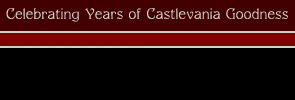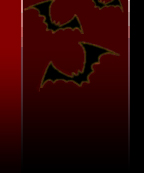|
Castlevania: Dawn of Sorrow (2005)

The original Metroid on the NES was filled with scary, freaked-out
moments, the best of which came in the final moments of the game. After
defeating Kraid and Ridley, you entered Tourian, with the best ambiant
music that square waves would possible generate, and you were just
SWARMED with those bastard Metroid things that seemed invincible,
unless you read the latest issue of the Nintendo Fun Club. And God help
you if you never found the Screw Attack to get through those stupid
fire rings. All of this insanity reached its pinnacle when the game
expected you to perform several feats of acrobatics up a narrow tube
whilst a countdown played ominously. It is, to date, one of the most
intense experiences to come out of any video game I've ever played.
As much as all second generation Castlevania games (Symphony and beyond) have aped Metroid, they never quite
got the climax down. Sure, Symphony had a nice false ending, but what
followed was simply a minor journey through an upside down castle,
which culminated in two incredibly easy boss fights. Harmony was much
the same, and while Circle had a fiercely difficult final boss, it
still just didn't have the right build-up.
The closest Castlevania ever came to getting it right was with Aria of
Sorrow. Once you beat Graham, you entered into the Chaos realm, a
spooky area with familiar with disconnected areas with washed out
colors. Sometimes you would exit a room and you would be in space. It
was freaky, but perhaps not freaky enough. The final boss looked
simultaneously gross and pretty, but it was still a cakewalk.
This has been a problem with every game since Symphony. All of the
Gameboy Advance games have tried to emulate Symphony so hard, but not quite
getting there. Once again, Aria came the closest, but as much as it
almost came to surpassing it, it still felt like things weren't fleshed
enough to surpass its glorious predecessor.
At first, Dawn of Sorrow seems to follow the same path as Aria - a
magnificent game, but still a shadow. I changed my mind come the final
area of the game. Up until that point, the castle design still seemed
uninspired, regurgitating the same areas and many of the same enemies
we'd seen several times before. Sure, the snow-covered village was
nice, but one of the later areas is simply an update of
the first level of the first Castlevania, complete with the 573rd remix
of the song Vampire Killer. And you think, did someone at Konami miss
the point? Practically ALL of the Castlevanias up to this point
included some kind of reference to this seminal stage, but did we
really need another one THIS blatant?
Anyway. the final area is, quite simply, Hell. There are skulls that
are perhaps from goats, and there is fire. It's about as much as you'd
expect, but it looks nice on the DS screen. Then it gets crazy, with
Egyptian architecture and more outer space backgrounds and a map screen
that kind of hops around haphazardly but still conforms to some kind of
pattern. The mid-boss is some kind of hopping lizard who appears to be
wearing a red suit. The background is a red haze with a single lonely
tree in the background. It's messed up and original and maybe just a
bit creepy. And, at this point, I got the feeling that maybe the folks
who made this game really, REALLY knew what they were doing - but maybe
they just weren't given enough time or resources to do it. The final
battle is even better, with a huge boss battle that, while not
impossibly difficult, is still an exercise in skill in the same manner
as oh-so-many classic Konami games.
In this aspect, Aria of Sorrow just sort of petered out around third base. Dawn of Sorrow takes it all the way home.
On that same note, I remember talking to one of my friends back when
Aria of Sorrow came back. We both agreed that the bad ending - wherein
Soma becomes Dracula - was awesome. But, wouldn't have it been even
cooler if you got to play as Julius is his quest through the castle to
destroy that white haired jerk? And yes, while there was an option to
play as Julius, it was the same half-assed alternate character modes
we'd seen with Richter and Maria in Symphony, or with Maxim in Harmony.
There were new play mechanics, yes, but it was stripped of so many
elements that made the main game so interesting.
Dawn of Sorrow doesn't play around. There is a similar bad ending in
Dawn. It is here you unlock Julius Mode, which actually has a (minor)
storyline this time. You kill bad guys, and you gain levels. While most
of the skills necessary to proceed are granted at the beginning, you're
still far too weak to face the final bosses (which differ from the main
game, which is another incentive to play through this mode) and
leveling up is a necessity.
And it just gets better. Yoko, who literally did nothing but sit around
and get stabbed in Aria of Sorrow, becomes a playable character. Like
her ancestor Sypha, Yoko uses the same three magic spells of fire, ice
and lightning, although the ice spell regrettably does not freeze
enemies. She attacks with a dumpy little staff, which has the pleasant
side effect of replenishing a bit of health.
And then there's Alucard.
As much as certain fans tend to bash Igarashi, he's gotten very good
with fan service lately. He was well aware that Castlevania kids
everywhere want to see their favorite angsty vamp back in action. And
here he is, looking almost as amazing as he did in Symphony.
Other touches flesh out the experience further. The soul gathering
concept from Aria is one of the most brilliant the series has even
seen, but many of them had varying strength levels, and many became
useless as the game progressed. Not anymore - the more souls of a
particular monster that you harvest, the stronger it gets. Souls can
also be used to upgrade weapons, which is done by visiting Yoko at the
opening stage of the game. Hammer is still around too, although he
mostly just sets up shop so he can hang around Yoko, whom he has a
silly, boyish crush on. There are still hidden rooms, but not many -
the designers must have realized that randomly slashing at brick walls
in hopes of finding a secret must have been more tedious than fun.
Instead, there are several obscure puzzles to solve, most of which
result in a useless item, but show a bit of inventive flair. There are
several hidden souls to collect, and you'll find clues in little
newspaper shards hidden around the castle. Konami tried to utilize the
touch screen of the DS by requiring that you draw seals before beating
bosses, and it succeeds by adding an extra bit of intensity to battles
that are still, for the most part, somewhat easy. But the advantage of
the DS really comes into play with the map screen, which is always
visible on the top screen. Bloody convenient, it is.
Once again, the plot is kind of there, used as a device to set up yet
another adventure into yet another castle. It's nice to see the
characters from Aria again, since the game seemed to have a large cast
that didn't do much. While the change in art style has been much
bemoaned by gamers who still think anime is for teh kiddies, it's
pretty decent, and at least superior to the now-retro look sported by
Dracula X (which came out over ten years prior.) New villains Celia,
Dmitri and Dario look a bit dorkier than the returning crew, and their
role in the plot - revive Dracula again blah blah - seems to be the
antithesis of what a good Castlevania plot should be. But we'll forgive
this and move on.
As much as Dawn of Sorrow is a pleasant evolution of its predecessor,
it unfortunately still feels a bit samey. All of the GBA titles had
distinguishing play styles, but this is technically just Aria all over
again. As mentioned, most of the castle areas aren't anything too
interesting, although the boss fights this time around are much more
inspired. The game still isn't very long or very difficult - getting
the best ending without going on any subquests took me about seven
hours on the first playthrough. Although, as mentioned, Julius Mode is
actually worth playing through, giving it a fair bit more replayability.
The DS is Nintendo's first portable system that is really comparable to
the Playstation as far as graphic hardware, and Dawn of Sorrow is the
first game that really comes close to matching it. The gorgeous
polygonal backgrounds used sparingly in Symphony are used much more
often here, to exquisite effect. While the DS has obviously has the
technical assets to match the PSOne, it's flaws are mostly artistic
ones. Many of the areas seem to lack the polish and inspiration of
Symphony - there's an area called the Wizardry Lab, which should bring
to mind the gorgeous Alchemy Laboratory of Symphony, but it looks
nothing of the sort. Soma - and most of the enemy sprites - look pretty
decent, but Julius and Yoko look a bit slipshod. It's still marvelous,
don't get me wrong, but it's one area where it could have been better.
And then there's the soundtrack. Composed by Masahiko Kimura, who
contributed greatly to the Castlevania 64 soundtrack, the music is much
more subdued, relying on soft piano melodies and gentle strings. Very
little of it is bad, and there are a few excellent songs ("Pitch Black
Intrusion", the snow village theme, and "Dracula's Tear", the Wizardry
Lab, are amongst the best), but overall, it feels to be lacking the
intensity that Castlevania games should possess. The samples also have
an unfortunate MIDI quality to them, although it does sound far better
than any GBA sound.
Dawn of Sorrow is still a superb game. Much like Aria, the formula does
appear to be wearing a little thin, but there are enough brilliant
moments of inspiration that propel Dawn far beyond the mere status of
"retread". It's an awesome game - you should buy it.
Dawn of Sorrow Artwork

Back to Top
Castlevania Games - Castlevania: Dawn of Sorrow
|
|
|



